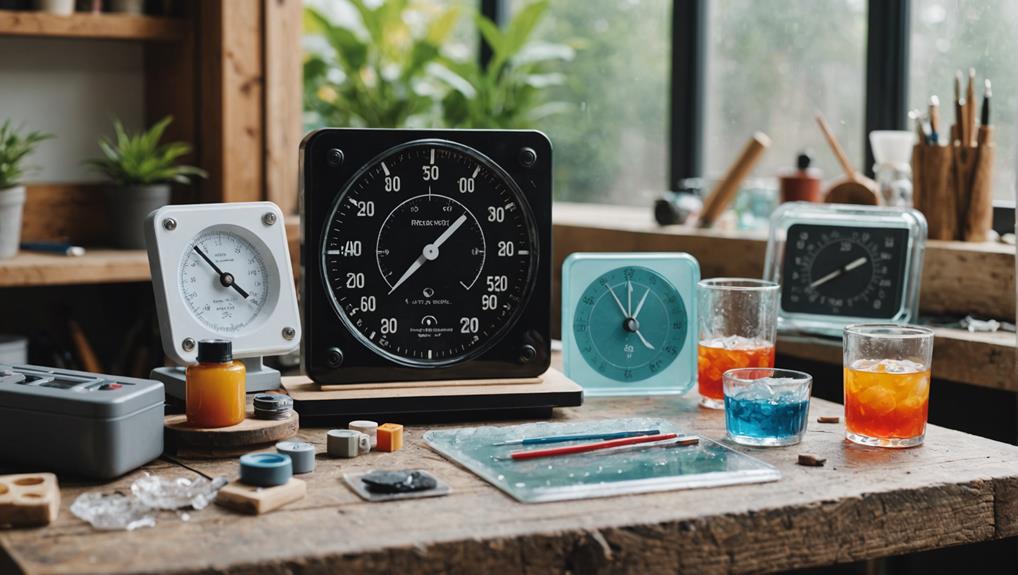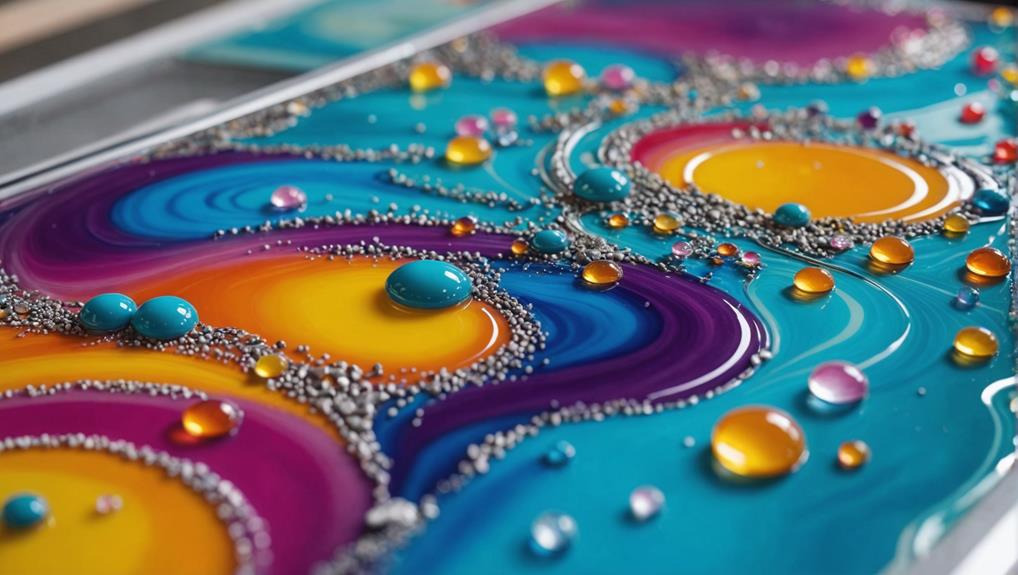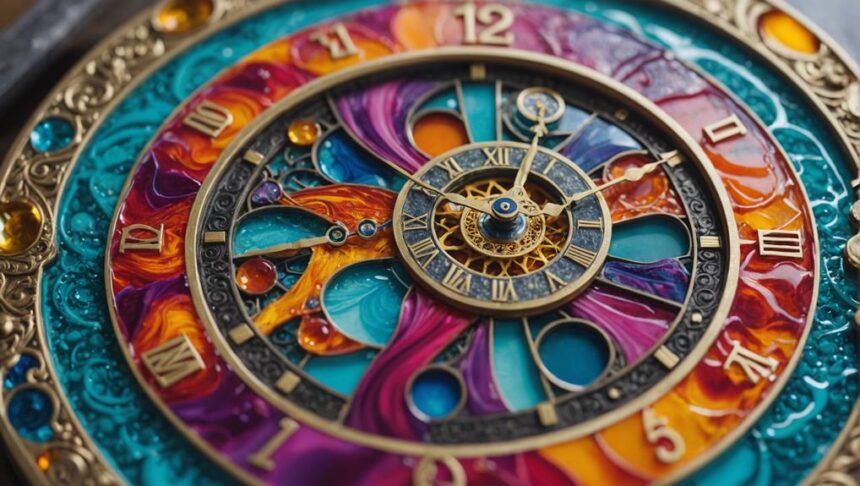Drying time for resin art varies by type and conditions. UV resin cures in minutes under a UV light, perfect for quick projects. Epoxy resin, used for larger pieces, takes 24 to 72 hours to fully dry. Polyester resin sets super fast, in just 15-20 minutes, great for big tasks. Polyurethane resin is quicker too, curing in 20-30 minutes, but needs precise mixing. Temperature, humidity, and even dust all play a big role. It sounds like magic, but there’s science behind getting it just right. Stick around, and we’ll uncover all the secrets!
Key Takeaways
- UV resin cures in minutes under UV light, ideal for small, quick projects.
- Epoxy resin takes 24 to 72 hours to cure, with touch-dry time in 24 hours.
- Polyester resin sets in 15-20 minutes when using MEKP hardener.
- Polyurethane resin cures within 20-30 minutes, suitable for simpler projects.
Types of Resin
Understanding the various types of resin is essential for selecting the appropriate material for your specific project needs. Each resin type has unique properties and application techniques that make them suitable for different uses.
First up, UV Resin is the speedster of the resin world. It cures super fast under UV light, usually within minutes, making it perfect for small projects when you’re in a hurry. Imagine making quick jewelry fixes or tiny art pieces without waiting forever!
Next, we have the powerhouse, Epoxy Resin. Known for its strength and durability, it’s great for projects that need to last, like furniture or large art pieces. But, patience is key here—curing can take 24 to 72 hours.
For those into fiberglass work, Polyester Resin is your go-to. Its curing speed is adjustable with MEKP hardener, typically setting in 15-20 minutes.
Then there’s Polyurethane Resin, which is quick and efficient, curing in 20-30 minutes. It’s ideal for simpler projects like charms and pendants, but mixing requires care.
Lastly, Hybrid Resins blend properties from different resin types, offering unique characteristics and drying times. They’re the wild card—perfect for experimental artists! Each resin type has its own quirks, so pick wisely for the best results.
Curing Process
The curing process for resin is like a magical transformation, and understanding it is key to creating beautiful art.
Epoxy resin usually takes a few days to fully harden, whereas UV resin needs just a few seconds under the right light.
And remember, the environment—like temperature and humidity—can totally change how fast or slow your resin cures.
UV Resin Curing
Achieving a flawless cure with UV resin hinges on the correct application of UV light and adherence to ideal environmental conditions.
When working with UV resin, understanding UV light sources and resin layering is key. To start, thin layers of resin, no thicker than 0.1 mm, cure best. If you pile it on too thickly, it can become a sticky mess. Use a UV lamp with at least 4 watts of power, or even direct sunlight if you’re feeling adventurous.
As you apply each layer, patience is your best friend. Allowing adequate time between layers prevents mixing and bubbling. This guarantees each layer is fully cured before moving on to the next. Think of it like baking a cake; you wouldn’t want to ice it before it’s fully cooled, would you?
Temperature and humidity play significant roles as well. A warm, dry space speeds up curing, while a cold, damp one might slow things down. If your surface feels sticky, it might need a bit more UV love. Test the hardness with a toothpick every few seconds, and soon enough, you’ll have a masterpiece that’s hard as a rock.
Epoxy Resin Timing
Epoxy resin requires precise timing in its curing process to achieve ideal results and durability. For most epoxy resin applications, the resin typically dries to the touch within 24 hours but reaches full curing in up to 72 hours. This means you can touch it after a day, but it’s still not as hard and durable as it will be.
The final flood coat of epoxy resin finishes, those beautiful glossy layers, usually needs about 72 hours at peak temperatures between 75°F to 80°F (24°C to 27°C) to hit maximum toughness. After that initial 24-hour period, the resin might still be a bit flexible, and you can demold it, but for the best hardness, waiting for the full cure is the way to go.
The pot life, or the time you have to work with the resin before it starts curing, is about 45 minutes. This can change based on how warm it is and how much resin you mix.
Communicating with customers about drying times is super important. Imagine explaining why their resin art masterpiece isn’t ready to hang on the wall just yet—it helps manage expectations and keeps everyone happy with the final product.
Environmental Impact
Understanding the impact of environmental factors on the resin curing process is essential for achieving ideal results and preventing common issues like incomplete curing and surface defects.
Temperature and humidity are big players here. Higher temperatures, around 75-85°F (24-30°C), speed up the curing process, while cooler temperatures can drag it out, making you wait longer for your masterpiece to set.
Humidity control is just as vital. High humidity can mess up the curing process, leaving your resin art sticky and unfinished. Yuck! To avoid these issues, it’s key to keep your workspace organized and maintain a consistent temperature and low humidity, especially during those critical first 24 hours of curing.
UV resin needs plenty of UV light to cure properly. If you’re using epoxy or polyurethane resins, keep an eye on the temperature and mix ratios. Too much or too little of either can spell disaster for your project.
Watch out for air circulation and dust, too. They can create bubbles and uneven surfaces, turning your smooth finish into a bumpy ride. So, control your environment to keep your resin art looking flawless.
Environmental Factors

Temperature, humidity, and ventilation are pivotal environmental factors that directly influence the drying time and overall quality of resin art.
When it comes to humidity effects, high humidity can be a real villain. It slows down the curing process and can even leave your resin sticky. Nobody wants that! So, keeping the humidity in check is super important.
Now, let’s talk temperature. If it’s too cold, your resin might take forever to dry. But if it’s nice and warm, between 75-85°F (24-30°C), it speeds things up. Think of it like baking cookies; you don’t want to burn them, but you also don’t want them raw.
Ventilation importance can’t be stressed enough. Good air flow helps to clear out any nasty fumes and keeps the workspace safe. Plus, it can indirectly help the resin cure better. Imagine trying to breathe in a stuffy room—not fun, right? Your resin feels the same way.
- High humidity: Slows down curing, can cause stickiness.
- Optimal temperature: 75-85°F (24-30°C) for faster drying.
Equipment and Tools
In resin art, having the right equipment and tools is vital for achieving professional results and guaranteeing a smooth workflow. One of the most important aspects is mold selection.
Silicone molds are fantastic because they come in all shapes and sizes, letting you create unique designs with ease. They also help the resin pieces pop out easily once they’re dry.
When it comes to mixing techniques, disposable cups and stir sticks are your best friends. They keep everything clean and prevent any unwanted contamination between batches. Mixing the resin and hardener thoroughly is key to achieving a smooth, bubble-free finish.
And here’s a pro tip: pre-warm your resin and hardener in hot tap water for 5-10 minutes before you mix them. This little trick can make a big difference in how well your project cures.
Don’t forget about safety! Gloves and masks are a must to protect your skin and lungs from irritating fumes.
For UV resin projects, UV lamps and handheld flashlights are vital for curing and hardening the resin. These tools guarantee that your art dries evenly and thoroughly, giving it that professional touch.
Common Issues
Common issues in resin art can greatly impact the final outcome, requiring careful attention to factors like curing, mixing, and environmental conditions.
One frequent problem is dealing with sticky surfaces. This often happens when the resin hasn’t fully cured, which can be caused by thick layers or improper mixing ratios. Ensuring a precise 1:1 ratio of resin to hardener is vital for achieving a solid, non-sticky finish.
Another pesky issue is bubble formation. Bubbles can form if you mix the resin too quickly or introduce moisture into the mix. To minimize bubbles, it’s important to mix slowly and apply heat, like using a torch or heat gun, to release trapped air.
High humidity levels can also mess with your resin art. Humidity can extend drying times and even prevent the resin from curing properly. Keeping your workspace dry and well-ventilated is essential to avoid these problems.
- Sticky surfaces often result from incomplete curing.
- Bubble formation can be minimized by mixing slowly and applying heat.
Troubleshooting
Addressing and resolving issues in resin art requires a methodical approach to troubleshooting, focusing on factors like curing times, mixing ratios, and environmental conditions.
One common problem is incomplete curing, often caused by applying resin in thick layers. To avoid this, keep layers no thicker than 0.1 mm, especially when using UV resin. If your resin feels sticky, it might need more UV exposure or additional time under the curing light.
Environmental conditions play a huge role, too. High humidity and low temperatures can mess up the curing process. Make sure your workspace is between 70°F and 85°F (21°C to 29°C) for the best results.
Another issue you might face is bubbles. Mixing slowly and applying gentle heat can help release trapped air, making your art look smooth and professional.
Mixing ratios are essential—always follow the manufacturer’s instructions for resin and hardener. Incorrect ratios can lead to uncured or poorly cured resin, which can ruin your project.
These troubleshooting tips and curing techniques can help you fix common problems and create stunning resin art every time.
Safety Precautions
Guaranteeing the safety of both the artist and the environment is paramount when working with resin. Handling resin can be exciting, but it’s vital to take the right safety measures to protect yourself and those around you.
First and foremost, always wear gloves and protective eyewear. This helps prevent skin irritation and shields your eyes from harmful fumes and splashes. When it comes to glove selection, opt for nitrile gloves as they offer better chemical resistance compared to latex or vinyl gloves.
Next, pay attention to ventilation tips. Resin emits fumes that can be harmful if inhaled, so working in a well-ventilated area is essential. Open windows, use fans, or even work outdoors if possible.
Here are a few key points to remember:
- Follow the manufacturer’s safety guidelines for the specific resin product you are using, as different types may have unique hazards.
- Dispose of resin waste properly according to local regulations to avoid harming the environment and guarantee safety.
Methods to Accelerate Curing
To speed up the curing process of your resin art, you can try increasing the temperature of your workspace to between 75-85°F, since warmer environments help resin cure faster.
Using heat mats or space heaters can keep this temperature steady, which is super important in the first 24 hours.
Also, applying resin in thin layers, no thicker than 0.1 mm, will make a big difference in how quickly it dries.
Increase Environmental Temperature
Elevating the ambient temperature to between 75°F and 85°F (24°C to 30°C) is a proven method to expedite the curing process of resin art. Keeping your workspace warm can make a big difference in how quickly your resin hardens, and it’s not too tricky to achieve!
Maintaining good temperature regulation and guaranteeing even heat distribution in your workspace is key. You’ve got to keep things consistent, especially during the first 24 hours of curing. Fluctuations in temperature can cause all sorts of problems, like bubbles or uneven hardness. Imagine you’ve made this beautiful piece, only to find it marred by imperfections because the temperature wasn’t stable—what a bummer!
To highlight the importance of a stable, warm environment:
- Consistent heat: A steady environment guarantees the resin cures evenly without defects.
- Pre-warming resin: Placing resin in hot tap water before mixing can give you a head start.
Utilize Heating Equipment
Utilizing heating equipment, such as heat lamps or space heaters, can effectively expedite the curing process of resin art by maintaining a stable and heightened ambient temperature. When you raise the temperature to between 75°F and 85°F (24°C to 29°C), the resin cures faster, meaning you spend less time waiting around.
Heating techniques, like using heat mats, are super helpful because they increase the temperature around your resin, speeding up those all-important chemical reactions.
However, it’s not just about cranking up the heat. Temperature monitoring is essential. You need to keep an eye on things to guarantee the resin doesn’t get too hot. Excessive heat can cause discoloration or make your resin cloudy, which is definitely not what you want.
Additionally, be careful with sudden temperature changes! They can cause bubbling or even cracks in your masterpiece, and nobody wants to see their hard work ruined by pesky bubbles.
Consistent Temperature Maintenance
Maintaining a consistent temperature between 70°F and 85°F (21°C to 29°C) is essential for accelerating the curing process of resin art, ensuring efficient and defect-free results. This temperature range helps speed up the chemical reactions in the resin, making it dry faster. Plus, it keeps your masterpiece looking perfect!
First off, how do you keep the temperature stable? Space heaters and heat lamps can be your best friends. They help maintain the ideal temperature range, so the curing process stays smooth and efficient. However, you need to avoid any sudden temperature changes during the first 24 hours. Trust me, you don’t want your beautiful resin art to end up with defects or improper curing.
Here are some quick tips:
- Use space heaters or heat lamps: These are great for keeping the temperature stable.
- Avoid thick resin layers: Thinner layers cure faster and more evenly.
Quality Considerations

When considering the quality of resin art, it’s vital to account for the potential yellowing caused by accelerators and the heat generated from fast curing methods.
Imagine spending hours on a beautiful piece, only to see it turn yellow over time. That would be a bummer, right? Yellowing prevention is key for clarity maintenance. Accelerators speed up the curing process but can cause the resin to yellow. To keep your art looking fresh and clear, go slow and steady with your curing process.
Fast curing methods can also generate heat, which might alter the color and appearance of your resin. Think of it like baking cookies—too much heat and they burn! This heat can compromise the quality of your final product, so it’s best to avoid shortcuts.
Even though there’s not much difference in hardness between resin cured for 24 hours and 72 hours, full curing (up to 7 days) guarantees durability. For heavy-duty items, this is essential. Imagine shipping a heavy piece only for it to break—yikes!
For lighter projects, slight differences in hardness might be okay, but knowing these details helps you make the best choices for your art’s quality and performance.
Frequently Asked Questions
How Much Time Does It Take for Resin Art to Dry?
Resin art drying times vary based on resin type, with epoxy taking up to 72 hours for full curing. Factors such as resin temperature effects and humidity influence can greatly alter these times, emphasizing the need for controlled conditions.
How Long Does Resin Take to Harden Fully?
The full curing time for resin varies by type, typically ranging from 24 hours to 7 days. Environmental factors such as temperature and humidity greatly influence resin curing, requiring careful consideration to guarantee ideal hardness and durability.
How to Make Resin Dry Faster?
To expedite resin drying, increase ambient temperatures using heat sources such as heat lamps or space heaters. Additionally, applying UV exposure, especially in thin layers, can greatly accelerate the curing process for UV-sensitive resins.
How Long Does Resin and Matting Take to Dry?
The drying time for resin and matting depends on resin types and matting techniques. Epoxy resins typically take 24-72 hours, while polyester and polyurethane resins dry faster. UV resin cures quickly under UV light within minutes.
Conclusion
In conclusion, understanding resin art drying times involves knowing the types of resin, the curing process, and the environmental factors at play.
Proper equipment and tools, along with troubleshooting common issues, guarantee better results.
Safety precautions are essential, and methods to accelerate curing can be useful.
Attention to these aspects guarantees high-quality resin art.
By grasping these details, artists can create stunning pieces with confidence and precision.


Leave a Reply